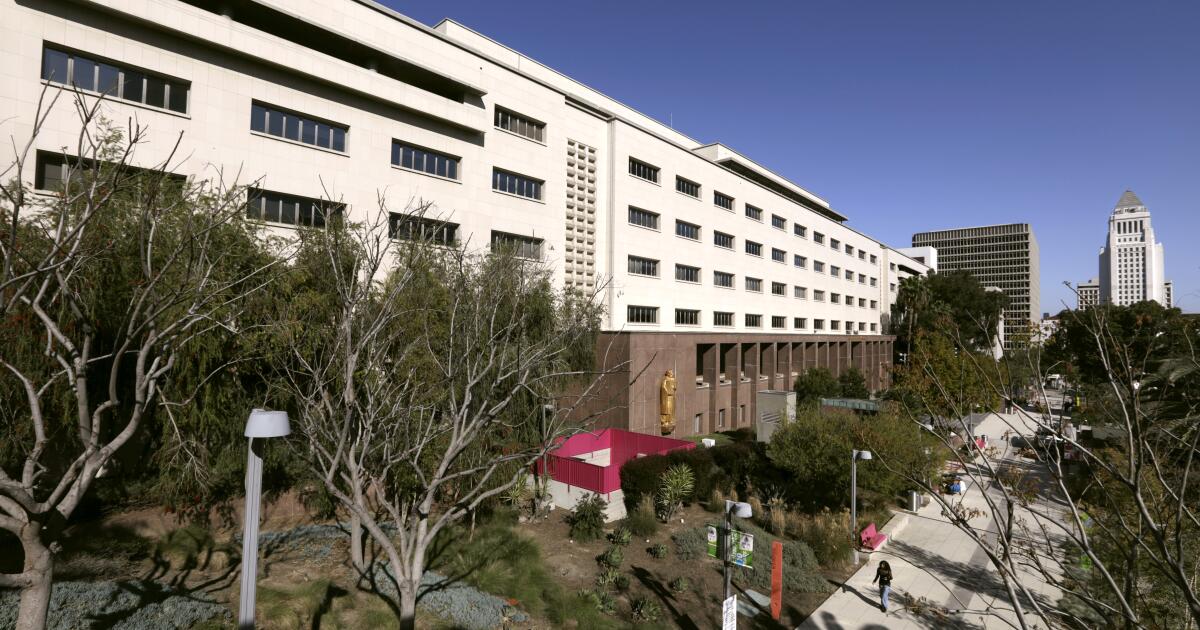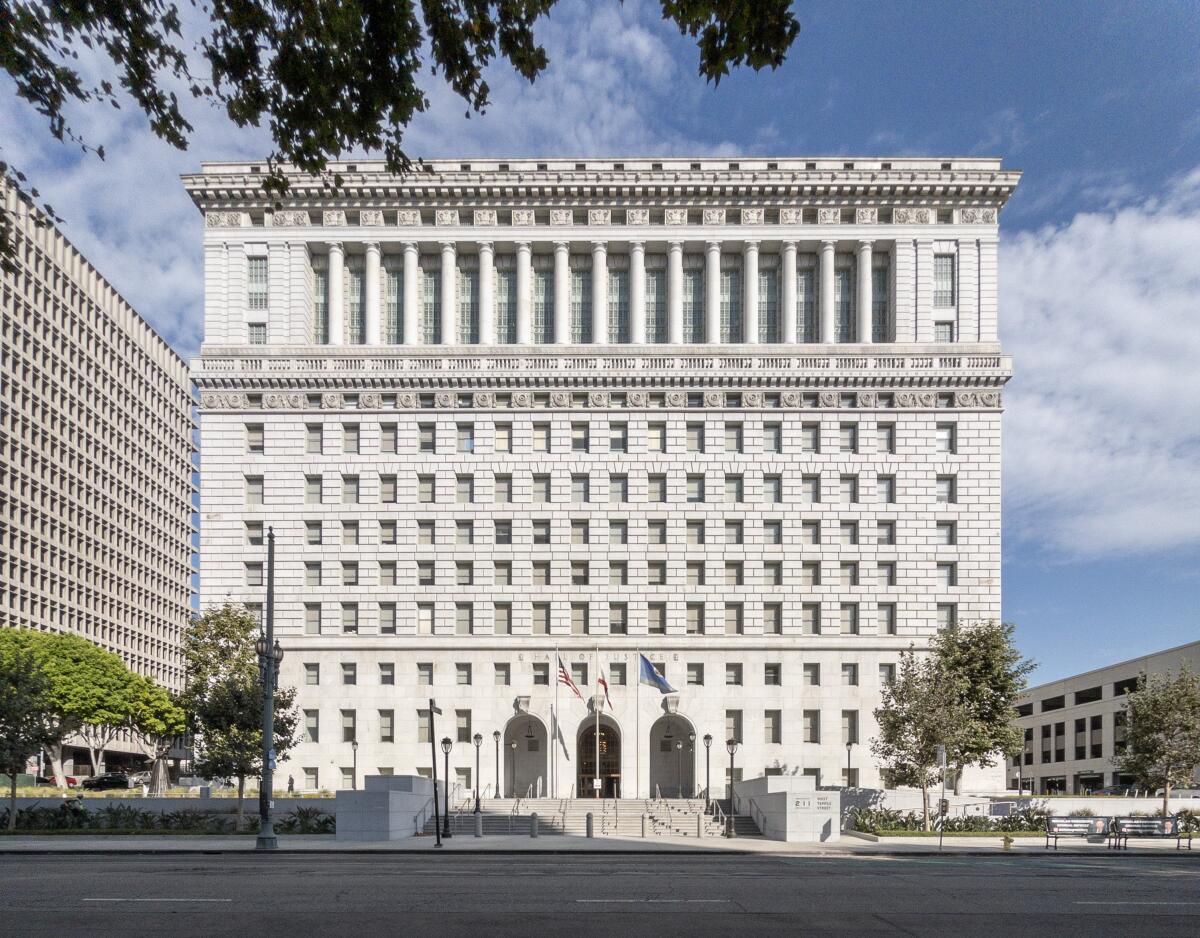Los Angeles County plans to demolish historic headquarters building

As the ink dries on Los Angeles County’s $200 million purchase of a downtown Gas Co. office tower, a debate is brewing over what to do with the 1960s-vintage headquarters its plans leave behind.
Supervisor Janice Hahn and preservationists are fighting a plan to move workers to a newly purchased skyscraper on Bunker Hill and raze the Kenneth Hahn Administration Hall. Renamed, it is the core building of the government-led Civic Center community.
“When I realized what was happening, I was devastated,” she said, accusing county officials of quietly pursuing what she said was a secret plan to relocate county authorities and thousands of workers. Then dismantle a factory.
“I think it’s a somewhat secretive process where they know what they’re doing but don’t fully reveal it,” she said.
However, county officials plan to begin moving workers from the administration hall and other county buildings to the downtown skyscraper next summer, a process that could take three to four years.
Los Angeles County’s $200 million purchase of a natural gas company building in downtown Los Angeles has closed, with county workers expected to begin moving in next summer.
(Myung J. Chun/Los Angeles Times)
The county’s preliminary plan calls for demolishing the administrative hall but preserving the building where the Board of Supervisors holds public meetings. The building is connected to the administrative hall, but it is a free-standing structure that can stand on its own.
County officials say plans to demolish the administrative hall are not set in stone. Formal planning for the future of the site will begin in early 2025, with a master plan should be completed in about a year, followed by an environmental review of the plan that could last until 2027. Yu’s purchase of the Gas Company building was funded in part by funds earmarked for seismic retrofits and other necessary repairs to the Administration Hall and other county buildings.
Hahn cast the lone “no” vote last month on the county’s purchase of the natural gas company building. When she first learned of the proposal to purchase the 52-story building facing foreclosure, she saw it as an opportunity for the county to make a profitable investment in a down market. The county may consolidate some of the offices there and then sell them at a profit when the office real estate market recovers.
Then, she said, “it was revealed” that the plan was to move the Board of Supervisors’ offices and county services to the gas company building and eventually demolish the administrative hall.
“It does make me uneasy and a little bit shocked because this was their plan all along,” Hahn said. “I think the public is still in the dark about this plan.”
Construction of the Executive Hall and other important Civic Center buildings, including the Los Angeles County Superior Court-Stanley Mosque Courthouse, began in the 1950s and is a source of civic pride.
The Times wrote in 1957: “What the Acropolis was to the golden age of ancient Greece, the new civic center now hewn into the shabby slopes of Bunker Hill will be to Los Angeles. “
According to reports, the construction period of the administrative hall will last a century. The Times said a capital projects analyst in the county’s chief administrative officer’s office “is prepared to bet that the Hall of Administration will still be in use in 2059.”
In 1992, the building was renamed the Kenneth Hahn Administration Hall in honor of Hahn’s father, the county’s longest-serving supervisor and a former Los Angeles City Councilman.
Hahn said she was not driven by his legacy to save the building.
“Hey, if you want to take the name off, if it makes you feel better about keeping it,” she said, “I’m fine with that.”
The head of the Los Angeles Conservancy, which advocates for the preservation of meaningful local architecture, said Executive Hall is “absolutely historic” and significant. It was designed by a distinguished team of mid-century architects, including Paul R. Williams, the first licensed black architect west of the Mississippi who designed movie star homes and famous of public buildings.
Adrian Scott Fine, chairman of the Environmental Protection Agency, said demolishing the executive hall would be “a mistake for many reasons”.
One of the reasons for keeping it, he said, was its location across from the Gloria Molina Grand Park and across the street from the Mosque Courthouse. The two buildings form a park connecting the town hall and the music center.
“These two buildings are an integral part of the Civic Center,” Fine said. “You can’t lose one without losing their original function.”
The public spaces of the administrative hall are filled with light brown marble and terrazzo, giving the hall an institutional feel. There appear to be areas in the building that need painting, patching and other maintenance.
“It’s a desolate place,” admits Will Wright, director of government and public affairs for the Los Angeles chapter of the American Institute of Architects and a regular visitor. “That tells me you really need to invest in its maintenance.”
Through investment, he said, the county can “restore and enhance” the internal environment, making it more attractive to employees and visitors.
Wright said ideally the county would own the natural gas company building and restored administrative hall, a position Hahn supported.
“I believe the funding needed to transform this project is still money that we can easily find in a $50 billion budget,” Hahn said in an interview in her office. “I think this is an issue that has been critical to Los Angeles County for decades. It’s not too much to say what the people mean.”

Los Angeles County oversaw renovations to the Hall of Justice a decade ago. This historic building was severely damaged by the 1994 Northridge Earthquake.
(Myung J. Chun/Los Angeles Times)
Dan Rosenfeld, a real estate developer and preservationist, said Executive Hall isn’t as ornate as other downtown landmarks such as Walt Disney Concert Hall, City Hall and the Los Angeles Water Authority headquarters, but it doesn’t need to be It’s important to be noticeable.
“Not every public building needs to be eye-catching,” he said. “It would be a very jarring city if they did that.”
Rosenfeld has worked to preserve other important historic downtown buildings that are seismically unsafe and threatened by the wrecking ball, including City Hall and the Hall of Justice, both of which date to the 1920s, Still in use after renovation.
“It was relatively simple to strengthen the building’s lateral seismic strength and modernize the interior,” Rosenfeld said of the executive hall. “This building can and should be saved.”
He said the administrative hall is part of the Civic Center, which contains public spaces and state, local and federal buildings that “define Los Angeles” and should not be abandoned by the county. He said the Civic Center “is a symbol of our democracy” and a place where citizens gather to celebrate, protest and mourn.
“The Civic Center is more than just a collection of buildings,” Rosenfeld said. “It’s a symbol of a community’s faith.”
Executive Fesia Davenport said the county will not neglect the civic center.
“We understand the importance of a vibrant and well-functioning Civic Center and are committed to maintaining the county’s presence in this important public space,” Davenport said in a statement. “When we open the Civic Center next year As we go through the master planning process, we will invite broad public input to help us make recommendations to the Board of Supervisors to help guide their decisions on how best to redesign our Civic Center building for optimal public service.
Completed in 1991, the 52-story Gas Company Building at 555 West Fifth Street is widely considered one of the city’s most prestigious office buildings. Mountain base.
Real estate brokerage JLL said more than half the building is leased to various tenants, including law firm Latham & Watkins and accounting firm Deloitte. Its namesake tenant, Southern California Gas Co, said in September it would move to another skyscraper one block north at 350 South Grand Avenue, which has been the building’s anchor tenant since it was completed. .
Times staff writer Rebecca Ellis contributed to this report.



